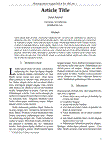| Summary: | juveniles at low dietary protein under laboratory conditions showed a feasible way at least in terms of weightgain (0.60 versus 0.47g live weight for PL52 raised on animal and plant diets respectively). L.vannamei is apromising species from this point of view to examine ontogenetic variations of its performance whetherreceiving animal or plant-based diets. Also, it is interesting to follow the performances of juveniles on amonotonous dietary treatment or with a drastic change between plant base (2.5g weight gain) and animal basediets (3.1g weight gain). It is the purpose of this work because data are presented at larval and postlarval stages.Performances can be produced in terms of recovered energy for larvae (5.2 J/larvae/day), and it helps to proposethe range of variation larvae exhibited while fed both dietary treatments and measure in particular digestibleenergy intake (1.1J/larvae/day at Zoea I), feces production on a basis of 82% digestible energy, ammoniaexcretion (0.02 J/larvae/day) and respiration (0.48J/larvae/day). Postlarvae required between 1 and 3J/Pl’s /daythat is in agreement with findings on other peneid species. Final assessment is made on a possible improvementin terms of energy expenditure in the two situations (PA and PV) and for the main periods of the life cycle(larvae, Pl’s, juveniles and pre-breeders). Energy demand is increasing with development stages and values willbe used to explore a model of feed distribution which should be adequate to maintain animals in optimumgrowth with a minimum wastage and a maximum water quality. Moreover, it is of importance through theenergy expenditure in both cases (PA and PV) to see up to which extent animals are going to sustain on all plantdiets while keeping performances (recovered energy in a range of 10-20% for juveniles) to get enough growthrate with a minimum of animal marine protein utilisation as a main source for this species.
|
|---|
